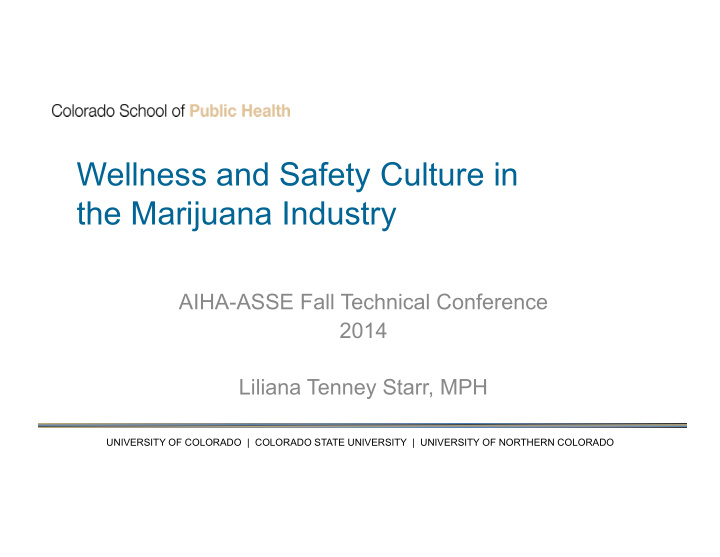



Wellness and Safety Culture in the Marijuana Industry AIHA-ASSE Fall Technical Conference 2014 Liliana Tenney Starr, MPH UNIVERSITY OF COLORADO | COLORADO STATE UNIVERSITY | UNIVERSITY OF NORTHERN COLORADO
Acknowledgements MAP ERC CDPHE Workgroup Interdisciplinary Team Mike VanDyke Kate Johnesee, Kevin Meredith Towle Walters, Stacy Hibiske, Elyse Contreras Brian Williams, Britt Mueller, Industry partners
Wellness & Safety Culture • Assess and describe opportunities to promote healthy behaviors among industry workers • Provide guidance to employers on how to promote a culture of wellness and safety, with specific examples of proven strategies appropriate for the industries • Identify organizational level interventions to improving health and safety • Identify training opportunities for health promotion and health protection
Overview • Introductions and MAP ERC Interdisciplinary Course • Fall 2013 Marijuana Grow Operation (MGO) Assessment • Observations (Total Worker Health Approach): – Environmental Exposures – General Safety – Ergonomics – Organizational Culture • Work processes and OSH recommendations • Future projects – PILOT Project Proposal – Worksite training
Project Overview • Medical marijuana grower, producer and retailer – 18 full time – 15 contracted – 45% women • Assessment to examine occupational and environmental health and safety • The Golden Child of MMJ • Adopting best-practices from agriculture • Expanding rapidly
Overall Observations • Organizational supports • Security • New technologies • Engineering controls • Air monitoring • Major focus on “Plant Health”
Environment • Building impairment • High humidity • High chemical concentration • Limited ventilation • Water systems • Fire and explosion hazards – Electrical – CO2 generators
PPE • Provide PPE engaging in potentially hazardous tasks • Latex gloves for trimming • Lab coats – to limit plant cross contamination • Half-mask 3M respirator for pesticide application
Potential Health & Safety Hazards • Skin and airway irritation (specific • Pesticides – limited exposures to strain) • Mold – none observed but no – Trimming times during harvest seem sampling was conducted to provoke reactions • Ergonomics - Awkward wrist • Elevated levels of CO and/or CO2 postures in trimming work (10-12 and other gases hours per day) • Ventilation and HVAC systems – – Modified work stations oxygen-depleted • Electrical systems • Pluming systems (not assessed)
General Safety Risks and Exposures Recommendations • Safety signage • Standing water • Identify best method for • Hoses humidifiers • High-intensity grow lamps • Identify and mark all slipping hazards • Tight spaces • Remove and properly dispose of any chemicals
Employee Use on the Job • 90-100% of employees are cardholders • They use medical marijuana before or during shifts • Instances of “over-medicated” employees on the job • Impact on work performance • Worker compensation policies
Other Observations • Retail security • Stigma: both industry and workforce • Hostile customers • Potential buffers: • Contractors during – Org. culture harvest – Social support • Seasonality – Autonomy and task rotation – Focus on “wellness”
Total Worker Health Provided services and • Cancer screening, benefits: prevention and survivorship • Tobacco control • Violence and harassment • Nutrition prevention plan • Stress Management • Health insurance • Mental Health (free • Incentives for participation counseling) • Substance Abuse **#1 factor contributing to providing benefits = high impact on employee job satisfaction
MAP ERC PILOT Project • Recognized need for further investigation • Applied for NIOSH PILOT funding through MAP ERC • Research-to-Practice (R2P) • 5 specific aims: – Understand worker population – Identify health, safety, and psychological work stress hazards – Assess awareness of OESH issues among workers – Identify workplace support systems – Disseminate results, provide training recommendations
Worksite Training • Translate findings into training recommendations – Primary, secondary, and tertiary • Disseminate throughout industry • Evaluate effectiveness – Trainee reactions and learning • Future goals – Work with CDPHE, OSHA, and NIOSH to determine OESH surveillance methods in this industry
Wellness & Safety Culture Assess and describe opportunities to promote healthy & safe behaviors among industry workers. Observations Opportunities – Conduct a workplace and – Strong leadership support for safety assessment employee health & wellbeing – Integrate safety and health – Currently, safety and health into manager and employee practice might be reactive – Make employee health and – Inconsistency of written safety a priority policies and practices – Communicate commitment to – Lack of training health and safety company- wide (consistently) – No instruction manual on how to build or operate a grow
Wellness & Safety Culture Assess and describe opportunities to promote healthy & safe behaviors among industry workers. Observations Continued ----- • Long work hours • Employees are cross-trained • Use of marijuana both on/off the job • Potential risks identified: – Retail: security and stress from dealing with difficult customers – Grow: potential chemical exposures, allergens – All: job security, stigmatization
Wellness & Safety Culture Provide guidance to employers on how to promote a culture of wellness and safety. – Conduct a worksite health and safety survey – Comply with all applicable OSHA standards – Communicate the importance of assuring safe and healthy workplace – Provide training, education and assistance to all employees
Wellness & Safety Culture Identify organizational level interventions to improving health and safety. – Establish safety goals based on OSHA standards and guidelines – Communicate commitment to safety and health – Create leading and lagging safety and health indicators – Engage owners and managers to educate them on safety and health best-practices
Questions? Thank you. UNIVERSITY OF COLORADO | COLORADO STATE UNIVERSITY | UNIVERSITY OF NORTHERN COLORADO
Recommend
More recommend